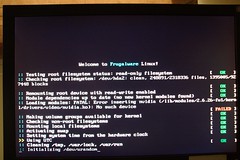While downloading, I was reading its documentation. I felt it's like Arch Linux, or any distro relating to KISS philosophy. But it should be a simpler installation.
The installation has only text mode, but we can have Framebuffer support while installing. My computer booted from DVD at 4:43 with USB keyboard and I chose 800x600x32 VESA mode, which is the largest one in screen resolution. It support to install with Software RAID. Doesn't have auto partition. I use cfdisk (there are other two utilities for use) to part one swap 2.1G, rest are root fs ext3. It will let you to format by choosing from text menu, you don't have to use mkfs manually. Then you can choose if you want to use expert menus, I chose not to. If you say yes, you can finely choose C libs/compiler/include files/... packages. I only add one more group, network-extra, because I need PPPoE and I don't know if network group already has it. Now, the Frugalware is installing 1141 packages for me, it's about 4GB unpacked size, took around 23 minutes to complete the package installation.
The following steps is installing GRUB bootloader, setting root password, creating a normal user, hostname, network connection. It shows dhcp, static, dsl, and lo. I set up static, then dsl. Next items are hardware clock, console mouse, X screen resolution. I use 1680x1050.
Done, took less than an hour.


It took about 50 seconds to login screen. The resolution is 800x600, would try to solve later. Default session is KDE 3.5. The first task is updating packages, but there is no PPP link. pppoe complains missing of /etc/ppp/pppoe.conf. After manually set one in /etc/ppp/peers, I have the Internet connection. So I ran pacman -Syu, amazingly no package need to update.
Now back to video problem. I don't have DRI. I installed nvidia package and removed libgl and libglx because of conflicts. Downloading speed is around 1 MB/s. But it seems to have problem to insert kernel module, I got an error "No such device". I updatedb, and check for nvidia.ko, it's there. So, I rebooted, it asked for a password to do that. I broke X. Reinstalling libgl and libglx with pacman -Sd libgl libglx, trying to reboot *figures crossed*.
I tried to see if this nvidia driver (173 series) support my card or not, it seems that I need to use legacy 96 series driver. I switch to console to run installer. The installer needs to compile kernel module, after few enters and rebooting, I saw nVidia logo! But the resolution is still wrong. however I have DRI (glxgears: 1,791 FPS) now. After manually edited xorg.conf and restarted X, I have 1680x1050 now.
 I plugged my camera and imported those photos, but I can't see them and there is no ufraw package. I have to use my laptop to do the job, don't want to use more time on it.
I plugged my camera and imported those photos, but I can't see them and there is no ufraw package. I have to use my laptop to do the job, don't want to use more time on it.The Adobe Flash has installed by default for Firefox 3, and audio works.
Well, I think that's all for this install. Honest speaking, I didn't encounter any real problems so far. However, I think it's definitely not for a newbie of Linux, especially those don't know how to solve a problem. Installation process is less an hour, it's not fast nor slow. You don't have to run any Linux commands if everything works fine. It takes about 4.8 GB storage for default options. The only drawback is booting takes too long, especially before init.
(This post was written within Firefox on Frgualware Linux 0.9)

 Posts
Posts Email Posts
Email Posts Comments
Comments
No comments:
Post a Comment
Any irrelevant comments to this post will be deleted. You can use these HTML tags: <b>, <i>, and <a>.